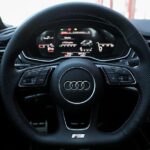Title: Legacy on the Track: Comparing McLaren’s Current Challenge to Ferrari’s Early 2000s F1 Dominance
In the world of Formula 1, few rivalries evoke as much passion and intrigue as that between McLaren and Ferrari. As McLaren finds itself reemerging as a competitive force in the modern F1 landscape, fans and analysts alike have begun to draw parallels to Ferrari’s reign of supremacy in the early 2000s. This era saw the Scuderia dominate the sport, capturing five consecutive Constructors’ Championships and paving the way for icons like Michael Schumacher to etch their names into the annals of racing history. Today, as mclaren navigates a comeback, the question arises: Can this storied team replicate the consistency and excellence that defined Ferrari’s golden age? In this article, we will explore the trajectories of both teams, examining their strategies, technological advancements, and the evolving dynamics of the sport, to understand what it truly means to dominate in the unpredictable world of formula 1 racing.
Evaluating Technical Innovation: McLaren’s Modern approaches Against Ferrari’s Early 2000s Mastery
In the realm of Formula 1, technical innovation reigns supreme, and McLaren’s contemporary strategies reflect a bold departure from methods that brought Ferrari unmatched success in the early 2000s. While Ferrari’s dominance was driven by a blend of engine power, aerodynamic efficiency, and a meticulously refined chassis, McLaren has shifted its focus towards embracing advanced computing and data analysis technologies to redefine performance on the track. Notably, their innovative use of simulation software and machine learning algorithms allows for an unprecedented degree of precision in vehicle setup and race strategy, underscoring a significant evolution in how teams leverage technology in pursuit of speed and consistency.
Comparing the two eras reveals stark contrasts in philosophy and execution. Ferrari’s triumphs were characterized by sturdy, well-tested designs that emphasized reliability and driver feedback. In contrast, mclaren’s modern approach encourages rapid iteration and real-time data adjustments, with a workforce that thrives on cutting-edge research and advancement initiatives. Key factors that differentiate their methodologies include:
- Engine Technology: McLaren’s hybrid power units versus Ferrari’s V10 monsters.
- Aerodynamics: Active aerodynamic elements in McLaren’s designs compared to Ferrari’s static but effective downforce solutions.
- Data Utilization: Real-time telemetry and analytics integrated deeply into McLaren’s race day operations.
| Feature | mclaren (Modern) | Ferrari (Early 2000s) |
|---|---|---|
| Engine | Hybrid & Turbocharged | V10 Naturally Aspirated |
| Aerodynamic Focus | Active Systems | Passive Optimization |
| Technology Integration | real-Time Data Analysis | Driver Feedback-Centric |
Driver Development and Talent Acquisition: Lessons from ferrari’s Success and McLaren’s Current strategy
The emergence of Ferrari in the early 2000s marked a golden era in Formula 1,where a robust driver development program and strategic talent acquisition were pivotal to their success. Under the guidance of key figures like Jean Todt and Ross Brawn, Ferrari meticulously cultivated talents such as Michael Schumacher, whose unparalleled skill complemented the team’s revolutionary engineering. The synergy between driver and machine facilitated innovations that redefined F1 racing,emphasizing the importance of cohesive teamwork. Key factors contributing to Ferrari’s dominance included:
- investment in Young Talent: Ferrari scouted up-and-coming drivers from karting circuits and junior formulae.
- Cohesive Team Dynamics: A culture of collaboration between engineers and drivers ensured seamless dialog.
- Data-Driven Decisions: Utilizing advanced telemetry allowed for real-time adjustments and strategy refinements.
In contrast,McLaren is currently refining its approach to driver development by focusing on a dual strategy of nurturing internal talent and securing experienced drivers through thoughtful acquisitions. With a roster that includes Lando Norris, the team is building a future-ready lineup while addressing the crucial area of mentorship—a lesson gleamed from Ferrari’s past successes. McLaren’s current strategy emphasizes a data-centric culture alongside fostering a competitive atmosphere, drawing from the stark realities of a highly competitive grid. Recent initiatives highlight:
- Scouting Programs: Increased investment in youth academies to spot talent early.
- mentorship Roles: Leveraging veteran drivers to support and guide younger teammates.
- Strategic Partnerships: Collaborating with technology firms for simulation and performance analysis.
Strategic Partnerships and Resources: Analyzing the Impact on Performance and Future Prospects in Formula 1
In the ever-evolving landscape of Formula 1, strategic partnerships have played a pivotal role in shaping team performance and long-term success. A prime example is how McLaren has sought to mimic the successful collaboration models established during Ferrari’s dominance in the early 2000s. At that time, Ferrari leveraged not only technical prowess but also strategic alliances with suppliers and sponsors, creating an surroundings that fostered innovation and resilience.McLaren’s recent focus on revamping its partnerships, particularly in areas such as aerodynamics, power units, and technology integration, aims to emulate the synergistic effects that propelled Ferrari to the top. The emphasis on cultivating robust supplier relationships has enabled McLaren to access cutting-edge developments, positioning them as potential challengers to the dominance of teams like Red Bull and Mercedes.
Moreover, the impact of these strategic partnerships extends beyond just immediate performance gains. By building alliances that encapsulate shared values and visions, McLaren is not only enhancing its competitive edge but also laying the groundwork for lasting growth.As illustrated in the accompanying table, the comparative analysis of key performance indicators between McLaren and Ferrari during their respective peak periods reveals significant insights into how collaborative efforts can lead to championship success.
| Aspect | McLaren (Current) | Ferrari (Early 2000s) |
|---|---|---|
| Drivers’ Championships | 0 (Since 2008) | 5 (2000-2004) |
| Technical Partnerships | Diverse Suppliers & Focused Alliances | Strong Institutional Partnerships |
| Innovation Investments | Increased R&D Budget | Consistent With Ferrari’s Heritage |
| Sponsor Engagement | Expanding Global Reach | Established Long-Term Contracts |
wrapping Up
the comparison between McLaren’s recent resurgence and Ferrari’s early 2000s dominance offers a fascinating insight into the ever-evolving landscape of Formula 1. While Ferrari’s reign was marked by visceral performances and unparalleled consistency, McLaren’s current trajectory reflects a blend of innovation and strategic evolution that could redefine the sport’s competitive dynamics. As both teams push the boundaries of technology and engineering, fans and analysts alike will be watching closely to see if McLaren can replicate or even surpass the legendary achievements of their rivals. The stage is set for a thrilling rivalry that harks back to a golden era, sparking debates about legacy, talent, and the relentless pursuit of victory that continues to drive Formula 1 forward.










